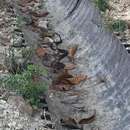ar
الأسماء في صفحات التنقل


Die Großaugen-Gebirgswassernatter (Pseudoxenodon macrops), auch Großaugen-Wassernatter, ist eine ungiftige Schlangenart aus der Unterfamilie Pseudoxenodontinae in der Familie der Nattern (Colubrinae). Die Schlange wurde 1855 durch den englischen Zoologen Edward Blyth unter dem Namen Tropidonotus macrops beschrieben. Als Terra typica wurde „near“ Darjeeling im nordöstlichen Indien angegeben.
Das Verbreitungsgebiet der Großaugen-Gebirgswassernatter reicht von Nepal und Bhutan über Nordostindien bis nach Vietnam und Borneo und nach Süd- und Mittelchina (Fujian, Guangdong, Guangxi, Guizhou, Sichuan und Yunnan).
Die Großaugen-Gebirgswassernatter kann eine Gesamtlänge bis 130 cm erreichen. Die Schuppen auf dem Rücken sind in 17 oder 19 Reihen angeordnet. Die Schuppen der oberen und mittleren Reihen sind gekielt, die Schuppen der untersten Reihen nicht. Die Anzahl der Bauchschuppen beträgt 151 bis 180, die Anzahl der geteilten Subcaudalia liegt bei 55 bis 80. Die Analschuppe ist geteilt. Vor dem Auge findet sich eine Präoculare, dahinter drei Postocularia. Die Anzahl der Oberlippenschilde (Supralabialia) liegt bei acht, wobei das vierte und das fünfte der Oberlippenschilde das Auge berührt. Die Anzahl der Unterlippenschilde (Infralabialia) beträgt neun bis zehn.
Farblich ist sie ziemlich variabel und kann bräunlich, grau, schwarzgrau, rötlich oder olivfarben gefärbt sein. Der Bauch ist weißlich bis gelblichweiß, einige vordere Bauchschuppen vollständig oder teilweise schwarz gefärbt. Die Oberseite kann durch rötliche, gelbliche oder schmutzigweiße Querbalken oder rundliche Flecken gemustert sein. Im Nacken findet sich eine V-förmige schwarze oder weiße Markierung, die aber auch fehlen kann. Im Allgemeinen werden die Musterungen im hinteren Körperbereich kräftiger.
Die Großaugen-Gebirgswassernatter lebt in der Regel in Bergwäldern, meist in Höhen von 1200 bis 2000 Metern, in kühlen Regionen jedoch auch niedriger. Sie ist tagaktiv und ernährt sich vor allem von Fröschen. Bei Bedrohung imitiert sie die giftigen Kobras und hebt dabei den Vorderkörper während der Nackenbereich abgeflacht und verbreitert wird. Zieht sich der Gegner nicht zurück, so beißt die Großaugen-Gebirgswassernatter zu oder flieht. Die Schlange ist ovipar. Ein Gelege enthält etwa zehn Eier.
Die Großaugen-Gebirgswassernatter (Pseudoxenodon macrops), auch Großaugen-Wassernatter, ist eine ungiftige Schlangenart aus der Unterfamilie Pseudoxenodontinae in der Familie der Nattern (Colubrinae). Die Schlange wurde 1855 durch den englischen Zoologen Edward Blyth unter dem Namen Tropidonotus macrops beschrieben. Als Terra typica wurde „near“ Darjeeling im nordöstlichen Indien angegeben.
Pseudoxenodon macrops, commonly known as the large-eyed bamboo snake or the big-eyed bamboo snake, is a species of venomous rear-fanged snake endemic to Asia.
P. macrops is a fairly variable species with brownish and almost blackish shades with short crossbars.
P. macrops preys on frogs and lizards.[3]
P. macrops is a venomous species. However, the potency of its venom is currently unknown.
P. macrops is an oviparous species. An adult female may lay as many as 10 eggs.[3]
There are three known subspecies including, the nominotypical subspecies.[2]
Nota bene: A binomial authority or a trinomial authority in parentheses indicates that the species or subspecies was originally described in a genus other than Pseodoxenodon.
P. macrops is found in Northeast India (Darjeeling, Assam, Arunachal Pradesh, Mizoram), Nepal, Bhutan, Myanmar, Thailand, West Malaysia, Vietnam, Laos, SW China (Yunnan, Guangxi, Guangdong, Fujian, Sichuan, Guizhou ?, Gansu).[2] It is also found in Sylhet region of Bangladesh.[4]
Pseudoxenodon macrops, commonly known as the large-eyed bamboo snake or the big-eyed bamboo snake, is a species of venomous rear-fanged snake endemic to Asia.
Pseudoxenodon macrops Pseudoxenodon generoko animalia da. Narrastien barruko Colubridae familian sailkatuta dago.
Pseudoxenodon macrops Pseudoxenodon generoko animalia da. Narrastien barruko Colubridae familian sailkatuta dago.
Pseudoxenodon macrops est une espèce de serpents de la famille des Pseudoxenodontidae[1].
Cette espèce se rencontre en Birmanie, en Chine, en Inde, au Laos, en Malaisie péninsulaire, au Népal, en Thaïlande et au Viêt Nam[1],[2].
Dans sa description[3] Boulenger indique que cette espèce mesure environ 78 cm dont 14 cm pour la queue. Son dos est vert olive avec des taches noires et jaunes ou orangé qui forment des bandes transversales surtout dans la partie postérieure du corps. Sa face ventrale est, dans sa partie antérieure, jaune ou orangé tacheté ou non de noir et, dans sa partie postérieure, verdâtre ou gris olivâtre foncé avec plus ou moins de mouchetures noires.
Selon Reptarium Reptile Database (10 septembre 2013)[4] :
Pseudoxenodon macrops est une espèce de serpents de la famille des Pseudoxenodontidae.
Rắn hổ xiên mắt to (danh pháp khoa học: Pseudoxenodon macrops) là một loài rắn trong họ Rắn nước. Loài này được Blyth mô tả khoa học đầu tiên năm 1855.[1] P. macrops là một loài khá biến đổi với màu nâu và gần như hơi đen với các thanh ngang ngắn. P. macrops ăn trên ếch và thằn lằn. P. macrops là một loài độc. Tuy nhiên, mức độ nọc độc của nó hiện chưa được biết. P. macrops là một loài đẻ trứng. Một con cái trưởng thành có thể đẻ được 10 quả trứng.
Rắn hổ xiên mắt to (danh pháp khoa học: Pseudoxenodon macrops) là một loài rắn trong họ Rắn nước. Loài này được Blyth mô tả khoa học đầu tiên năm 1855. P. macrops là một loài khá biến đổi với màu nâu và gần như hơi đen với các thanh ngang ngắn. P. macrops ăn trên ếch và thằn lằn. P. macrops là một loài độc. Tuy nhiên, mức độ nọc độc của nó hiện chưa được biết. P. macrops là một loài đẻ trứng. Một con cái trưởng thành có thể đẻ được 10 quả trứng.
斜鳞蛇(学名:Pseudoxenodon macrops)为游蛇科斜鳞蛇属的爬行动物,俗名气扁蛇、臭蛇、中华斜鳞蛇、大斜鳞蛇、草上飞。分布于印度、尼泊尔、缅甸、泰国、越南以及中国的福建、河南、湖北、湖南、广西、四川、贵州、云南、西藏、陕西、甘肃等地,常栖息于高原山区以及山溪边、路边、菜园地、石堆上。其生存的海拔范围为700至2700米。该物种的模式产地在印度阿萨姆、大吉岭附近。[1]